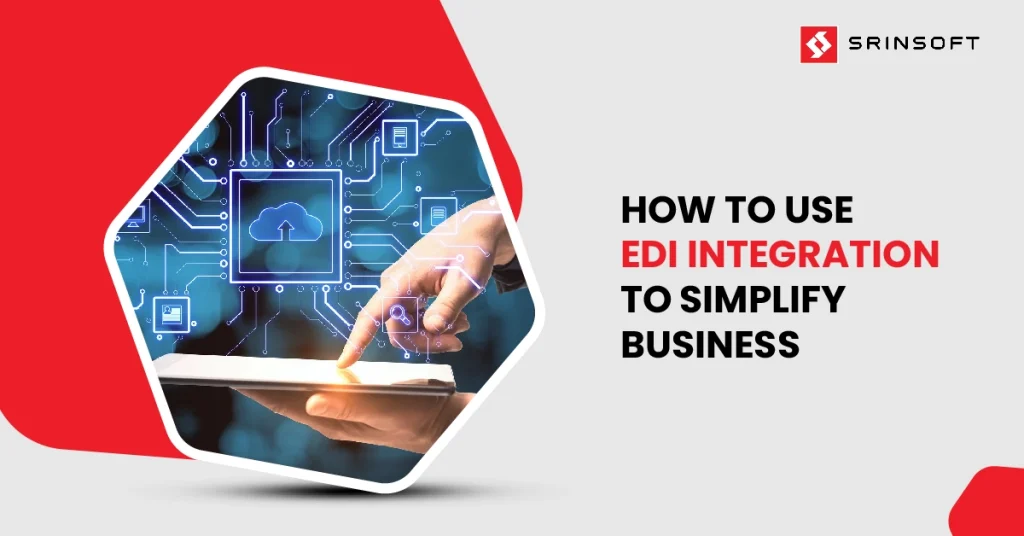
Introduction
Efficient communication and data exchange are crucial for staying competitive in today’s commerce. Automation for transacting vital business information has become more important than ever to achieve it.
What is fast becoming a new norm or mandatory, one might say, is for all parties in a trade to have a complete picture of the process from the first step to the last. EDI integration has therefore become a key to streamlining core business processes.
In addition, the automation that EDI entails will also greatly expedite processes and lower error rates as well as offer total traceability from OtoP (Order-to-Payment).
Such transparency is paramount in meeting the growing demands of customers and partners who expect real-time updates as well as smooth collaboration.
But first, in this piece let us understand the reasons for the sharp rise of EDI integration and how it works along with the advantages that businesses can gain from it.
What is EDI?
Electronic data interchange (EDI) is a method that helps businesses to receive and send out electronic documents in their existing enterprise management systems.
EDI rose to prominence because it would take paper files used in documentation and turn them into computerized information packages that could be shot easily back and forth from one computer to another.
Traditionally, businesses used paper documents like purchase orders and invoices, which had to be physically entered into computers. These processes were slow and had a high error rate.
Nevertheless, things have changed with the introduction of EDI, as it can extract the same information from enterprise applications and convert them in standard electronic formats like ANSI X12 or UN/EDIFACT.
EDI is designed in such a way that the structure & content of the documents have a consistent format (irrespective of the device) so that other computer systems are able to easily process them with accuracy.
Although purchase orders and invoices are the most exchanged documents via EDI, a wide range of business documents can be shared. Following is some of the popular documents exchanged via EDI
- Advance Ship Notices: Notifications sent in advance to inform the receiver about upcoming shipments.
- Inventory Reports: Detailed reports on stock levels and inventory status.
- Shipping Status Updates: Real-time updates on the status and location of shipments.
- Customs Information: Documents required for clearing goods through customs.
- Payment Details: Electronic remittance advice and payment notifications.
Importance of EDI
We know that EDI drastically improves how businesses share information by replacing paper-based documents with electronic equivalents. This helps companies cut down lead times and enables them to enhance their operational performance.
Here are some of the important reasons for companies to consider EDI.
Better Efficiency and Data Accuracy
Since EDI automates the exchange of business documents, it cuts down the dependence of data entry and processing on manual work which in turn reduces errors, corrections, and rework.
This streamlines the transactions, saving time in business processes due to delays and increasing overall workflow efficiency.
Additionally, information can be exchanged between systems so precisely and predictably with EDI because it uses standards such as ANSI X12 or UN/EDIFACT to maintain information consistency.
Standardizing in this manner means two things – fewer mistakes and information consistency across users.
Streamlined Supply Chain
Exchanging documents through EDI reduces delays and errors that occur due to human intervention. This in turn creates a more efficient supply chain, enabling firms to be better prepared for variations and ensuring operations run smoothly.
Cost and Time Savings
EDI reduces costs by automating the exchange of multiple documents. Since EDI is paperless, you can reduce your expenses on printing, storage and mailing services. It also eliminates manual data entry, in turn reducing errors and the costs associated with correcting them.
Shorter transaction processing timelines translate to orders being executed rapidly resulting in better cash flow and inventory management. Additionally, EDI’s standardized formats enable smoother data integration across various systems which further streamlines operations and reduces IT maintenance costs.
Data Privacy and Risk Reduction
By minimizing manual data entry errors, EDI ensures that information is exchanged accurately. EDI solutions also have extremely secure encryption protocols to protect data during transmission.
EDI also makes sure there is data privacy through secure authentication methods and access controls. Secure communication channels, such as AS2 or SFTP are also used by EDI systems to prevent unauthorized interception.
These security measures, along with real-time transaction monitoring and automated detection of errors, help companies maintain data integrity and adhere to regulatory standards.
This ensures that businesses don’t become prey to data breaches or fraud.
What is EDI Integration?
EDI integration is the process of setting up transmission of business documents between your company’s systems and your trading partners’ systems.
EDI Integration enables you to automatically and accurately exchange key documents such as purchase orders, invoices & shipping notices without the need for manual input.
How EDI Integration Works
Mapping Data Fields
Mapping data fields means matching the fields in your EDI documents with the corresponding fields in your internal systems. This fields that need to be mapped can come from tools like Enterprise Resource Planning (ERP) and Warehouse Management Systems (WMS), to Customer Relationship Management (CRM) or Supply Chain Management systems.
This mapping provides a guarantee that data is exchanged correctly between your own systems and the partner system.
Establishing Workflows
To set up EDI integration, companies need to define the EDI documents and protocols they will use to exchange data with their trading partners. This involves:
- Defining Trading Partners: Identifying who you will exchange EDI documents with.
- Setting Up Endpoints: Determining which IT systems will send, receive, and process EDI data.
- Specifying EDI Documents and Transactions: Deciding which specific business documents need to be exchanged.
- Choosing EDI Standards: Select the standardized formats (like ANSI X12 or UN/EDIFACT) that your messages will follow.
- Selecting EDI Protocols: Determining the technologies for transmitting your messages.
Automating Data Exchange
Once the workflow is set up, EDI software handles the translation, sending, and mapping of EDI data to and from your systems and those of your partners.
This process eliminates the need for manual data entry, reducing errors. Messages are exchanged instantly and automatically, ensuring timely and accurate communication.
Transform Your Workflow with EDI Integration – Get Started Today!
Challenges in EDI Integration and How to Overcome Them
Integrating EDI to in your business can have numerous benefits, but it also comes with its own set of challenges. Here, we will discuss some common issues businesses face during EDI implementation and how to overcome them.
Initial Setup and Investment
EDI requires a huge investment in terms of infrastructure, software and expertise who can effectively manage the system from time to time. This can be a challenge for small-budgeted businesses.
Although it might come with significant initial expenses, the ongoing savings and efficiencies often make them worth the cost. You can always have it as a phased implementation to not swallow all costs at once or survey the cloud-based EDI solutions that doesn’t even require much in-house infrastructure and are more cost-effective.
Complexity and Compatibility
With the various EDI standards, versions and protocols out there connecting to every partner can be a complicated process. A customer may use the same application from both a desktop and mobile phone, but compatibility issues can arise because of difference in technology implementations on those two sides.
This is where an integration platform as a service (iPaaS) can come to save you from these complex scenarios. They are capable of translating and harmonizing data across different formats recognizably making it conspicuous to enable partners for conversations.
Also, working with an established EDI provider can streamline setup and maintenance efforts.
Security and Data Privacy
EDI involves the exchange of sensitive business information, so integrity of such data becomes extremely critical particularly in regulated industries or where cross-border transactions are involved.
Encryption and using protected data transfer methods will ensure sensitive information is secure. Data privacy and integrity can also be achieved through regular security audits, and compliance checks.
In addition to that using managed EDI services can also increase security by leveraging the expertise and infrastructure of the provider.
Managing High Data Volumes
The more trading partners, the higher volume of transactions and the harder it is to manage all that data. This includes data quality, cost associated with handling a growing volume of data.
Automating data validation and error detection processes can significantly improve data quality and reduce manual workload.
You can also opt for cloud-based EDI solutions which can be increased/decreased as per your business volume. These implementations usually provide various pricing options making it easier to control costs.
Unlock the Power of EDI Integration – Start Now
Interoperability
If different EDI formats are employed by the trading partners interoperability problems can occur.
A powerful iPaaS solution that can implement various EDI formats, as well as protocols, helps fill the gaps between different systems.
Data governance platforms that can automatically convert data into required formats will help remove these roadblocks, thus enabling seamless interoperability with other trading partners.
Conclusion
So there you have it, EDI integration a powerful tool for those businesses looking out to make their operations more efficient. Automation of exchanges in documents like invoices, purchase orders and shipping notices helps businesses save money, cut back on errors and speed up the process.
EDI ensures seamlessly exchanging information between partners helping to streamline and expedite communication.
While implementation of EDI integration is a significant investment, it has the potential to yield substantial long-term benefits such as higher customer satisfaction and competitive advantage.
Adopt EDI for remaining competitive in a fast-paced digital world. EDI can help businesses to be more competitive and succeed as the market grows.
FAQs
What are the three types of EDI?
There are 6 Types of EDI, namely Direct or Point-to-Point EDI, EDI via VAN, EDI via AS2, EDI via FTP/VPN, SFTP, FTPS, Web EDI and Mobile EDI.
What is EDI ERP integration?
EDI ERP integration is a process of enabling data to automatically flow between a business’ “front-end,” EDI application, and its “back-end,” ERP system.
What is EDI in CRM?
Electronic data interchange (EDI) is a common protocol for information sharing between a supplier and a retailer selling that supplier’s products. When the two parties exchange documents, EDI automates the translation of the data into a standardized format.
Who uses EDI?
EDI is widely used across various industries, including retail, manufacturing, healthcare, logistics, finance, and more. Its adaptability makes it suitable for any sector that engages in electronic data exchange with trading partners.
Why is EDI used?
The technology offers secure, encrypted data transmission as an alternative to paper processes, resulting in improved supply chain tracking, reduced errors, and less time spent on data entry.
What are the key elements of EDI?
There are two key elements in basic EDI – First, electronic documents replace paper documents. Second, the exchange of documents takes place in a standardized format. Using these two basic concepts, any business can enter the world of EDI and begin taking advantage of the speed and economy of electronic commerce.


